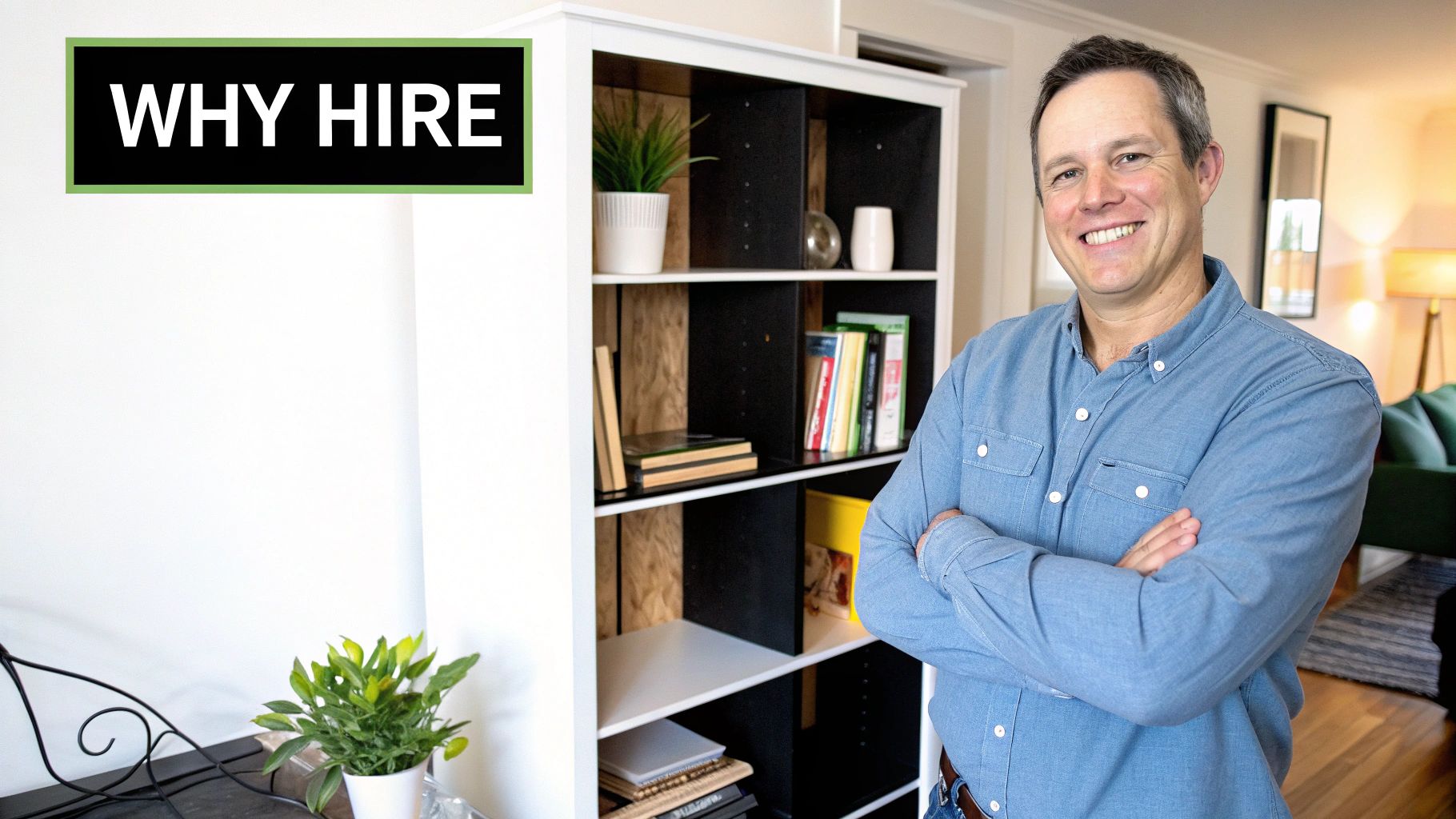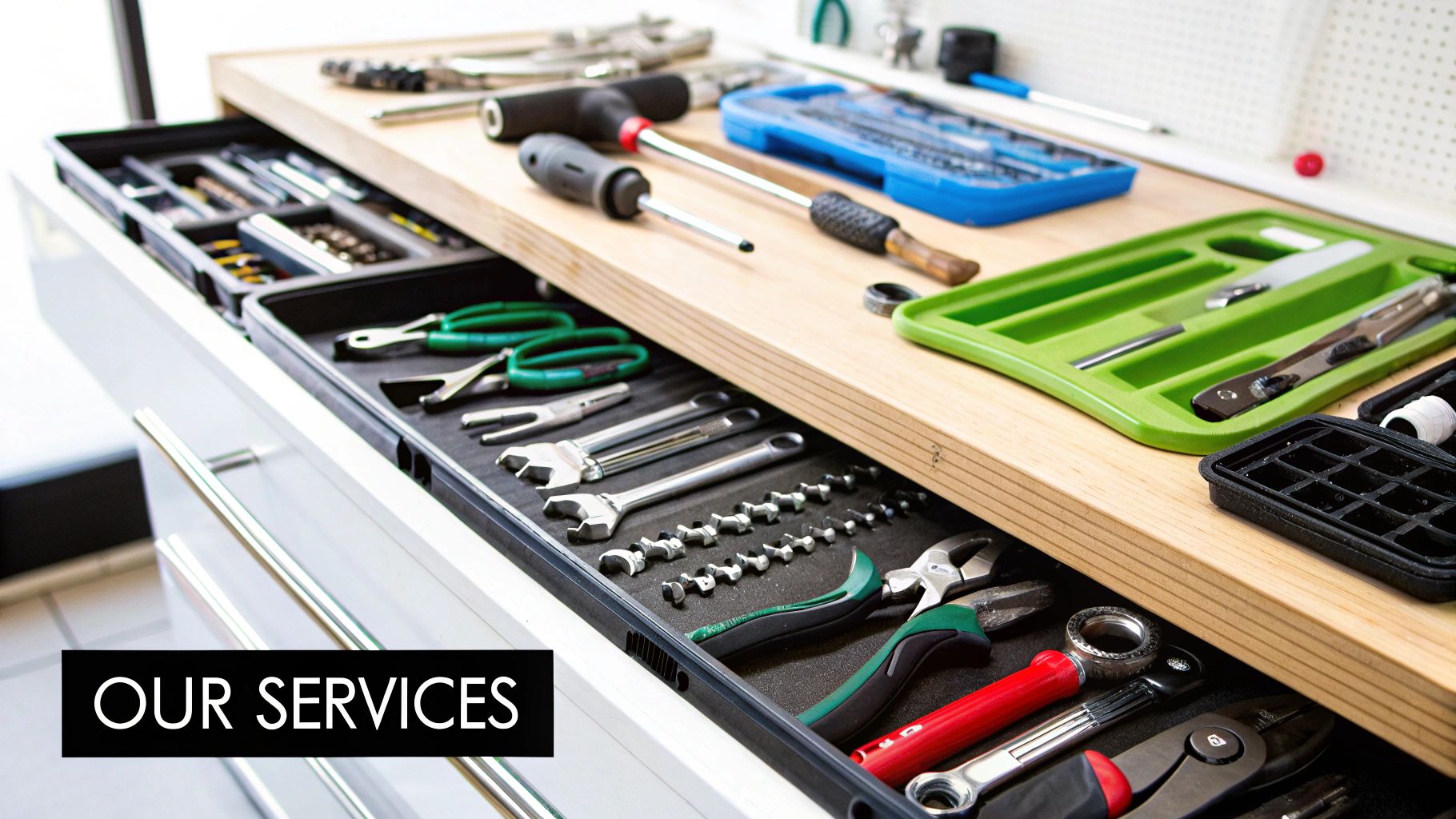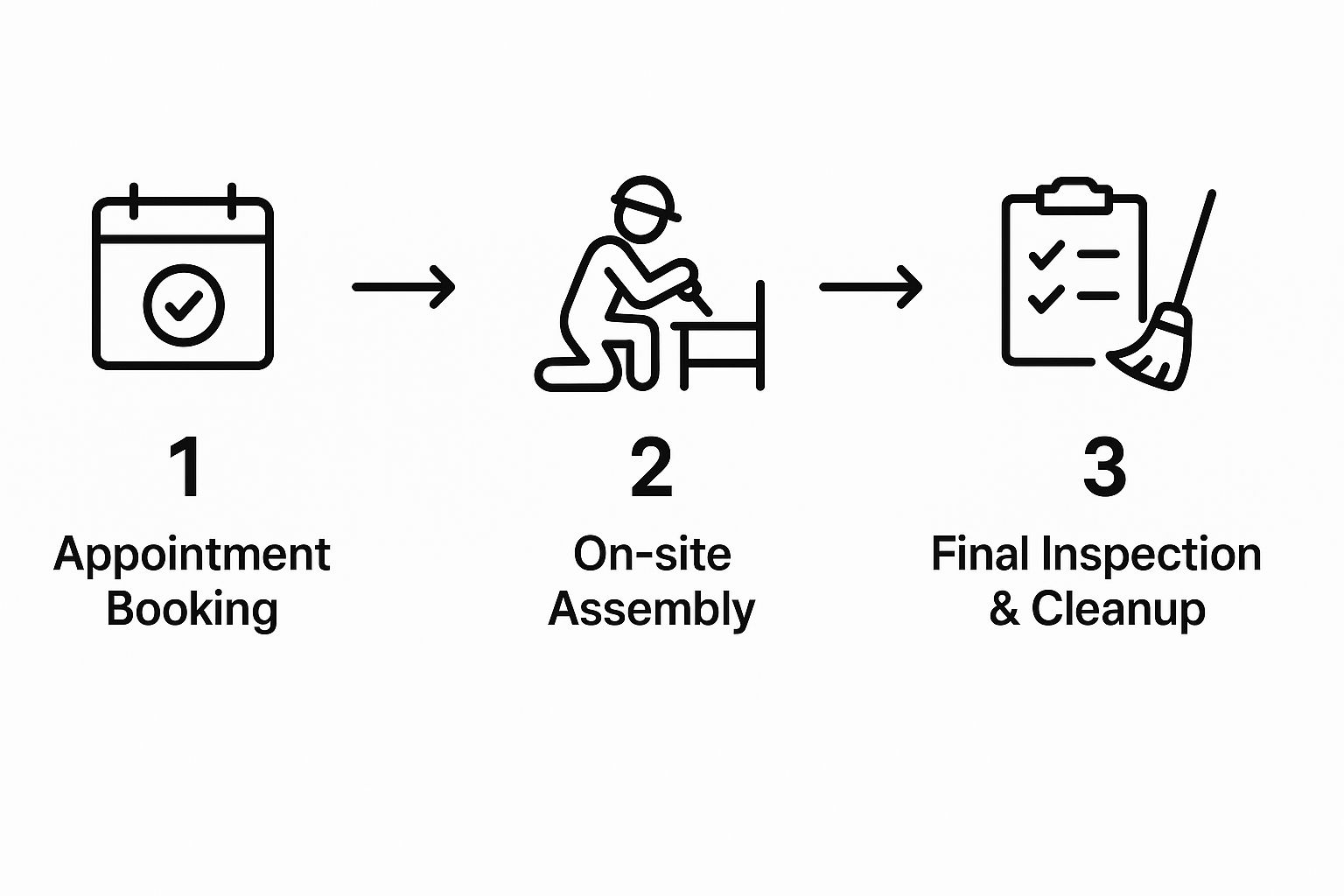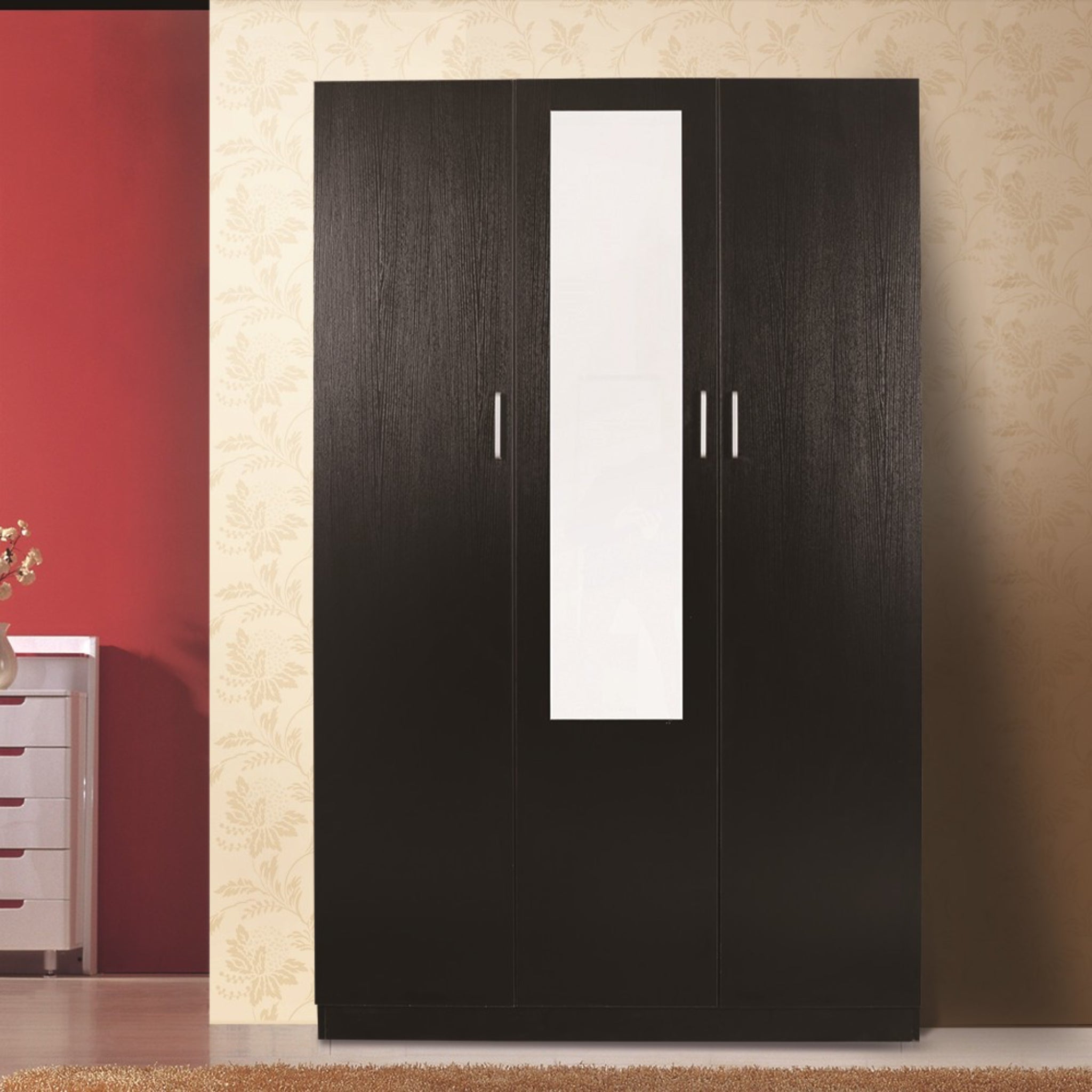That new flatpack box sitting in your hallway is full of potential—a stylish new bed, a much-needed wardrobe, or the perfect desk. But let's be real, for many of us, it also represents a weekend of frustration, squinting at confusing diagrams, and the dreaded hunt for that one missing screw. Finding reliable furniture assembly services near me can completely change the game, turning a stressful chore into a seamless upgrade for your home.
Why Hiring a Pro Assembler Saves More Than Just Time

The most obvious perk of bringing in a professional is getting your time back. We’ve all been there—what looks like a two-hour job quickly eats up an entire Saturday. Instead of wrestling with allen keys and MDF panels, you could be focusing on work, family, or just enjoying your weekend.
But the real value goes far beyond just saving a few hours.
Protecting Your Investment
You didn't just buy a box of wood; you invested in a piece of furniture you expect to last for years. Professional assembly is the final, crucial step in protecting that investment.
An expert knows exactly how to make sure every joint is tight, every screw has the right tension, and every panel is perfectly aligned. This attention to detail prevents those common DIY mistakes that cause furniture to wear out too soon.
Think about it:
- Wobbly legs? That’s usually from unevenly tightened bolts.
- Sticking drawers? Probably a case of misaligned runners.
- Crooked doors? Almost always caused by incorrectly installed hinges.
A professional build means your furniture works exactly as the designer intended, guaranteeing it will stand the test of time. You end up saving money on future repairs or, worse, having to replace it altogether. This is more important than ever, as Australians continue to invest heavily in their homes.
The Australian furniture market is currently valued at USD 2.98 billion and is expected to grow substantially. This reflects a major trend in home improvement, with people buying more complex, modular pieces that really need a skilled hand to assemble correctly.
A professional assembly isn’t just about convenience; it’s quality assurance for your purchase. It guarantees the structural integrity of your furniture from day one—something a rushed DIY job can rarely promise.
Ensuring Safety and Stability
Beyond just making your furniture last longer, proper assembly is a critical safety issue. A poorly built bookshelf can easily become a tipping hazard, especially with kids around. An unstable bed frame can lead to some seriously sleepless nights or even collapse.
Professional assemblers have the experience to spot potential structural problems and fix them on the spot. They know how vital wall anchoring is for tall units and understand how to ensure every single component works together to create a solid, secure final product.
For more insights on furnishing your home, you can explore additional tips and guides on our blog.
Your Smart Search for Local Furniture Assemblers

We've all been there. You type a generic phrase into Google and get hit with a tidal wave of irrelevant results. Finding the right furniture assembly services near me requires a bit more finesse than that. The secret is to move beyond broad terms to build a solid list of local, qualified pros who can actually get the job done right.
Instead of just searching "furniture assembler," get specific. Think about the exact item you have and your suburb.
For example, you'll get much better results with phrases like:
- "IKEA PAX wardrobe builder in Alexandria"
- "Fantastic Furniture assembly services Sydney"
- "Flatpack bed assembly Melbourne CBD"
This simple trick instantly cuts through the noise. It brings up specialists who know your specific furniture brand and, crucially, work in your area. This saves you the headache of calling a company only to discover you're outside their service radius.
Tapping Into Community Knowledge
Beyond a smart search, your own community is often the best place to find trusted recommendations. People are usually happy to share a great experience, and you can use that to your advantage on platforms where locals gather.
Community-focused hubs like local Facebook groups or Airtasker are fantastic for this. You can either post the job and see who responds or just ask for recommendations from neighbours who’ve hired assemblers before. Look for genuine, detailed feedback—not just a tagged business page. Pay close attention to comments about their punctuality, professionalism, and the quality of the finished assembly.
A quick tip: When you see a recommendation in a community group, don't just take it at face value. Send the person who recommended them a direct message. Ask what they had built, if the quote was accurate, and if they'd hire them again. This gives you far more insight than a simple "thumbs up" ever could.
What to Look for on a Provider's Website
Once you've got a shortlist of potential assemblers, it’s time to do some digging on their websites. A professional, informative site is usually a good sign of a reliable service. Don't just skim the homepage; go a little deeper to find the details that matter.
A quality website should clearly show you:
- A defined service area: This is non-negotiable. Look for a map or a list of suburbs to confirm they actually come to you.
- A gallery of past work: Photos of completed projects are proof of their experience and the standard of their work.
- Clear contact information: A phone number, email address, and even a physical address signal transparency and legitimacy.
- Customer testimonials or reviews: Even if they're curated, they can still give you a feel for the customer experience they aim to provide.
By checking for these key elements, you can quickly weed out the less professional operators and zero in on the assemblers who take their business seriously. This groundwork ensures you’re only reaching out to genuinely qualified local experts for a quote. And speaking of choices, if you're still deciding on the pieces themselves, have a look at our guide on how to choose the perfect furniture for your living room for some helpful ideas.
How to Vet and Compare Assembly Services
So, you've got a shortlist of local assemblers. Now the real work starts. It’s easy to just compare prices, but finding a truly reliable pro—one who won’t leave you with a wobbly wardrobe or a surprise bill—requires a bit more digging. The idea is to properly vet each option, looking for the details that signal real quality and trustworthiness.
Your first question, before you even discuss the job, should be about public liability insurance. This isn't just a formality; it's your safety net. If an assembler accidentally damages your brand new floorboards or puts a scratch in the furniture itself, their insurance is what covers the cost. If they're uninsured, that risk falls entirely on you.
Don't feel awkward asking for proof. Any legitimate business will have their Certificate of Currency on hand and will be happy to show you. If they get defensive or try to brush off the question, that’s a massive red flag. Cross them off your list and move on.
Digging Deeper Than Surface-Level Reviews
Online reviews are a goldmine of information, but you have to know how to read them. Don't just look at the glowing five-star testimonials they’ve cherry-picked for their own website. You need to get the full picture by checking independent platforms like Google, local directories, or even community Facebook groups.
Look past the star rating and focus on the details in the comments.
- Do people consistently mention the assembler was on time and professional?
- Are there comments about how they left the workspace—clean and tidy?
- Did they tackle a complex piece of furniture similar to what you need built?
A pattern of detailed, positive feedback across multiple sites tells a much more convincing story than a handful of perfect scores on their homepage. This kind of due diligence is more important than ever. Australia's furniture market is booming, with the office furniture sector alone projected to hit USD 2.5 billion by 2033, according to IMARC Group's detailed report. More people are buying quality pieces, and they need skilled hands to assemble them correctly.
The difference between a good assembler and a great one often comes down to the small things. Look for reviews that mention problem-solving skills, clear communication, and a genuine respect for the customer's home. These are the hallmarks of a true professional.
This is the kind of professional workflow you should expect, from the moment you book to the job's completion.

A clear, straightforward process like this means no surprises and minimal disruption to your day.
Evaluating Brand-Specific Experience
Let’s be honest: not all flatpack furniture is the same. Building a simple bedside table is a world away from assembling a complex, custom dining suite. When you're chatting with potential assemblers, be sure to ask about their experience with the specific brand and type of furniture you've bought.
Someone who has put together dozens of IKEA PAX wardrobes will know all the tricky steps and will get it done in half the time of a novice. Likewise, if you've splashed out on a high-end piece from a niche brand, you want a technician who is familiar with its specific fittings and build process. A perfectly assembled dining table, for example, is essential for it to function as the heart of your home. We actually have a whole guide on the top reasons to have a dining table at home that touches on this.
To keep your research organised, a simple comparison table can be a huge help. It allows you to see all the key details at a glance.
Comparing Local Furniture Assembly Providers
| Provider Name | Quoting Method (Hourly/Fixed) | Insurance Confirmed (Yes/No) | Average Review Score | Specialises in My Furniture Brand? |
|---|---|---|---|---|
Filling this out as you go makes the final decision much easier and ensures you haven't forgotten a crucial detail.
Ultimately, trust your instincts. A quote that seems too good to be true usually is. Rock-bottom prices often mean no insurance, a lack of experience, or a plan to tack on hidden fees later. Go with the provider who communicates clearly, answers your questions with confidence, and feels professional from that very first phone call.
Getting a Solid Quote Without Nasty Surprises

Let's be honest, the biggest worry when hiring any professional is the final bill. Vague estimates are a recipe for frustration, so the goal is to lock in a quote that's rock-solid, leaving no room for surprise charges later on.
It all starts with understanding how these services charge. You'll generally come across two main pricing models when looking for furniture assembly services near me: a fixed price per item or a simple hourly rate.
A fixed price is perfect for standard, off-the-shelf items—think of a classic IKEA Billy bookcase. The assembler has likely built hundreds of them and knows exactly how long it takes. On the other hand, an hourly rate makes more sense for custom furniture, large modular systems, or complex builds where the job's scope isn't so clear-cut. For a single, tricky wardrobe, a fixed price gives you peace of mind. But if you have a whole room of smaller, simpler items, an hourly rate might actually work out cheaper.
The Secret to an Accurate Quote? Give Them the Right Details
The quote you get is only as good as the information you provide. To save yourself the hassle of endless back-and-forth emails or, worse, a miscalculation, get all your ducks in a row before you even reach out.
Here’s what your potential assembler needs from you for a precise quote:
- The specific product name or SKU. Don't just say "a double bed." Instead, specify "the Koala Balmain Bed Base in a Queen size." See the difference?
- A link to the product page. This is a game-changer. It lets them see the exact item, check its dimensions, and sometimes even download the instruction manual in advance.
- A quick photo of the space. Snap a picture of where the furniture will be assembled and its final home. This helps them anticipate any spatial constraints before they even arrive.
- Any access hurdles. Let them know about that narrow apartment hallway, the three flights of stairs, or the tricky street parking. These things can impact the time needed and, therefore, the cost.
An accurate quote is a team effort. The more detail you give the assembler about the job, the more precise they can be with their pricing. This simple step is the best way to avoid "scope creep" and extra charges on the day.
Asking the Right Questions to Uncover Hidden Costs
Once a quote lands in your inbox, it's time to play detective. Don't just assume it covers everything. A few strategic questions now can prevent your final bill from ballooning. As professional assembly grows in popularity across Australia for both homes and businesses, the best companies are completely transparent about what’s included.
Make sure you ask about these common add-ons:
- Packaging Disposal: Will they haul away the mountain of cardboard and plastic, or are you stuck with it?
- Wall-Mounting: Attaching heavy items like bookshelves or entertainment units to the wall is a critical safety step, but it’s often considered an extra service with an additional fee.
- Travel or Parking: Is there a standard call-out fee? What happens if paid parking is the only option nearby?
Getting clarity on these points means the number you agree to is the number you'll actually pay. And once your furniture is beautifully assembled, you’ll want to keep it looking great. Our guide on how to care for laminated products has some great tips to help extend its life.
Getting Your Home Ready for Assembly Day
A little bit of prep work can make a world of difference on assembly day. When you take a few moments to get things in order before your assembler arrives, you're setting everyone up for a smooth, efficient process. It means they can get straight to work, which saves you both time and potential stress.
The biggest thing you can do is clear out a dedicated workspace. And I don't just mean shoving the coffee table to the other side of the room. Your assembler needs enough space to lay out every single panel, screw, and component. The working area required is often much, much larger than the finished piece of furniture itself.
Think about putting together a big, multi-door wardrobe. The technician will likely need to build the main frame flat on the floor before lifting it into place. A cluttered room not only gets in their way and slows them down, but it also ups the risk of something getting scratched or damaged – either your home or your brand-new furniture.
Clear the Way for a Smooth Build
Before the assembly team even rings your doorbell, try to get all the flatpack boxes into the room where the furniture will actually live. This is a huge help. It saves them from having to navigate heavy, awkward boxes through your house, a task that often isn't part of their standard service.
While you're at it, do a quick check of the delivery.
- Count the boxes and make sure they match what's on your delivery docket.
- Give the packaging a once-over for any obvious signs of damage.
Catching a missing box or a badly crushed corner before your assembler shows up is a lifesaver. You can contact the retailer right away to sort it out and reschedule the assembly if you need to, potentially saving you from a wasted call-out fee. It’s a five-minute check that can prevent a major headache.
Your assembler will turn up ready to build, with all their own professional tools in hand. They’re there to do one thing well: assemble your furniture. They aren't removalists, so they won't be able to move your old furniture or haul heavy boxes up three flights of stairs.
What to Expect on the Day
The whole process is designed to be as straightforward as possible. Your technician will usually start by unboxing everything and methodically laying out all the parts and hardware. This isn't just for neatness; it's how they confirm every single piece is there before they even think about picking up a screwdriver.
After the item is built, they'll tidy up the cardboard and plastic from their immediate work area. Just keep in mind that getting rid of all that packaging is typically your responsibility, so have a plan for it.
The final step is the most important: the walkthrough. This is your chance to look over the finished piece with the professional. Open the drawers, check the cabinet doors, and make sure everything feels solid and works as it should. Once you’ve given it your seal of approval, the job is done.
If you're setting up a new bed, this is also the perfect time to get everything else in place. Speaking of beds, our guide on whether you should you buy a mattress protector is a great read to help you protect that new mattress right from the get-go.
Got Questions About Furniture Assembly? We’ve Got Answers.
Even when you've decided to call in a professional, it’s completely normal to have a few last-minute questions. Getting these sorted will give you the confidence you need to book someone. Let's run through some of the most common things people ask us.
How Long is This Actually Going to Take?
This is the million-dollar question, and the honest answer is: it depends. The complexity of the furniture is the biggest factor. A simple bedside table might be done in under an hour, but a beast of a wardrobe is a different story.
To give you a rough idea, here’s what we typically see:
- A standard queen bed frame: You're usually looking at 1 to 2 hours.
- A large multi-door wardrobe (think IKEA PAX): These are more involved, especially with all the drawers and inserts. Expect it to take 3 to 5 hours.
- A chest of drawers: Generally falls somewhere in the 1.5 to 2.5-hour range.
The reason a professional is so much faster is simple experience. They’ve likely built your exact item dozens of times before, they have the right power tools, and they know the instruction booklets back-to-front. It's always a good idea to ask for a time estimate when you get a quote.
What if a Piece is Missing or Broken?
It’s the worst feeling – you open the box and a vital screw is gone or a panel has a huge crack down the middle. It happens. The first thing a professional assembler will do is a quick inventory check against the manual.
If they spot a problem, they'll stop and let you know straight away. Their job is to build the furniture, not fix manufacturing mistakes. You'll need to get in touch with the retailer where you bought it to sort out a replacement part.
A seasoned pro will do more than just point out the problem. They’ll help you identify the specific part number from the manual, which saves you a massive headache when you're on the phone with customer service.
Do I Need to Dig Out My Own Tools?
Nope, not at all. One of the biggest perks of hiring someone is that they arrive with a van full of everything they could possibly need. You can leave your Allen keys in the drawer.
A professional's toolkit is extensive and includes things like:
- Power drills with every imaginable bit
- Rubber mallets to gently nudge pieces into place without leaving a mark
- Levels to make sure every shelf and door is perfectly straight
- All the speciality wrenches and drivers that certain brands love to use
All you need to provide is the furniture (still in its boxes) and a clear space for the assembler to get to work.
Is It Worth Hiring Someone for Just One Small Thing?
This really comes down to what you value more: your time or your money. Most assembly services have a minimum call-out fee, which usually covers the first hour or two of work. If you just have one tiny bookshelf, the minimum charge might feel a bit steep.
But consider this: if that "small thing" is a surprisingly tricky ergonomic office chair or a fiddly set of drawers, paying a professional can be well worth it. You’re not just buying their time; you're buying the certainty that it’s assembled correctly, safely, and without you wanting to throw it out the window after a frustrating afternoon.
Ready to skip the frustration and get your new furniture built right the first time? DLB Furniture offers expert assembly services to ensure your pieces are sturdy, safe, and ready to enjoy. Explore our services and get a quote today!










